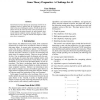AAAI
2008
14 years 2 months ago
2008
A key trend in (electronic) commerce is a demand for higher levels of expressiveness in the mechanisms that mediate interactions. We develop a theory that ties the expressiveness ...
AAAI
2008
14 years 2 months ago
2008
With the aim of fluency and efficiency in human-robot teams, we have developed a cognitive architecture based on the neuro-psychological principles of anticipation and perceptual ...
AAAI
2008
14 years 2 months ago
2008
In this paper, we study a sequential decision making problem. The objective is to maximize the average reward accumulated over time subject to temporal cost constraints. The novel...
AAAI
2008
14 years 2 months ago
2008
Two dimensional plots (2-D) in digital documents on the web are an important source of information that is largely under-utilized. In this paper, we outline how data and text can ...
AAAI
2008
14 years 2 months ago
2008
In order to interact successfully in social situations, a robot must be able to observe others' actions and base its own behavior on its beliefs about their intentions. Many ...
AAAI
2008
14 years 2 months ago
2008
Unifying first-order logic and probability is a long-standing goal of AI, and in recent years many representations combining aspects of the two have been proposed. However, infere...
AAAI
2008
14 years 2 months ago
2008
This paper summarizes recent work reported at ICAPS on applying artificial intelligence techniques to the control of production printing equipment. Like many other real-world appl...
AAAI
2008
14 years 2 months ago
2008
Game theory has been playing an increasingly visible role in computer science in general and AI in particular, most notably in the area of multiagent systems. I briefly list the a...
AAAI
2008
14 years 2 months ago
2008
We address the problem of minimizing the propagation of undesirable things, such as computer viruses or malicious rumors, by blocking a limited number of links in a network, a dua...
AAAI
2008
14 years 2 months ago
2008
Automated generators for synthetic models and data can play a crucial role in designing new algorithms/modelframeworks, given the sparsity of benchmark models for empirical analys...





